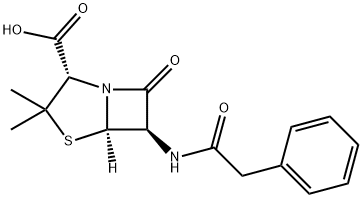Analysis standard , 61-33-6
Synonym(s):
(2S,5R,6R)-3,3-Dimethyl-7-oxo-6-[(2-phenylacetyl)amino]-4-thia-1-azabicyclo[3.2.0]heptane-2-carboxylic acid;Benzylpenicillin
CAS NO.:61-33-6
Empirical Formula: C16H18N2O4S
Molecular Weight: 334.39
MDL number: MFCD00069665
EINECS: 200-506-3
| Pack Size | Price | Stock | Quantity |
| 100mg | RMB304.00 | In Stock |
|
| others | Enquire |
PRODUCT Properties
| Melting point: | 82-83 °C |
| Boiling point: | 663.3±55.0 °C(Predicted) |
| alpha | D +282° (ethanol) |
| Density | 1.2729 (rough estimate) |
| refractive index | 1.6930 (estimate) |
| storage temp. | 2-8°C |
| solubility | H2O: 100 mg/mL |
| form | powder |
| pka | 2.45±0.50(Predicted) |
| color | Crystals |
| Water Solubility | 2.675g/L(25 ºC) |
| CAS DataBase Reference | 61-33-6(CAS DataBase Reference) |
| EPA Substance Registry System | 4-Thia-1-azabicyclo[3.2.0]heptane-2-carboxylic acid, 3,3-dimethyl-7-oxo-6-[(2-phenylacetyl)amino]- (2S,5R,6R)- (61-33-6) |
Description and Uses
Penicillin was the first natural antibiotic used to treat bacterial infections and continues to be one of the most important antibiotics.The name comes from the fungus genus Penicillium from which it was isolated. Penicillus is Latin for brush and refers to the brushlike appearance of filamentous Penicillium species.Species of this genus are quite common and appear as the bluish-green mold that appears on aged bread, fruit, and cheese. The term penicillin is a generic term that refers to a number of antibiotic compounds with the same basic structure. Therefore it is more appropriate to speak of penicillins than of penicillin.
The general penicillin structure consists of a β-lactam ring and thiazolidine ring fused together with a peptide bonded to a variable R group. Penicillin belongs to a group of compounds called β-lactam antibiotics. This in turn inhibits the formation of peptidoglycan cross-links in bacteria cell walls.
Antibacterial.
Safety
| Symbol(GHS) |  GHS07 |
| Signal word | Warning |
| Hazard statements | H317 |
| Precautionary statements | P261-P272-P280-P302+P352-P333+P313-P362+P364 |
| Hazard Codes | Xn |
| Risk Statements | 42/43 |
| Safety Statements | 36/37 |
| WGK Germany | 2 |
| RTECS | XH9700000 |
| F | 10-23 |
| HS Code | 32041900 |
| Hazardous Substances Data | 61-33-6(Hazardous Substances Data) |
| Toxicity | LD50 orl-rat: 8 g/kg ANTCAO 12,249,62 |


